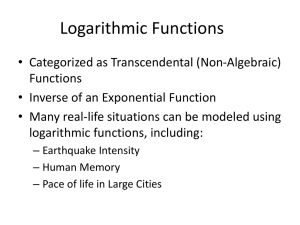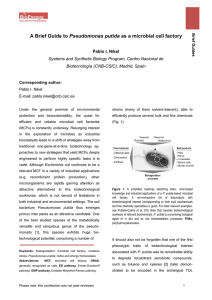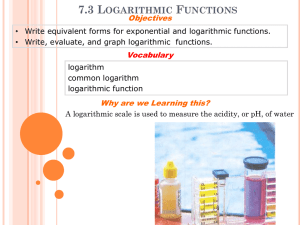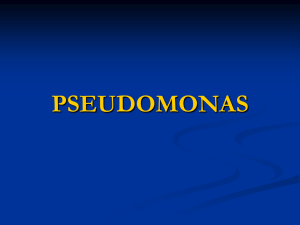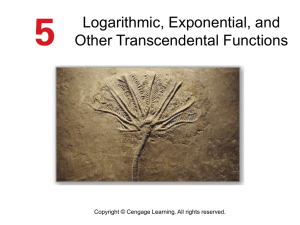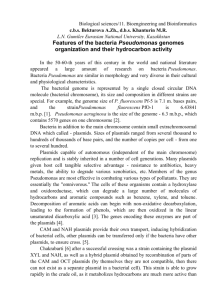Presentation - Utah State University
advertisement
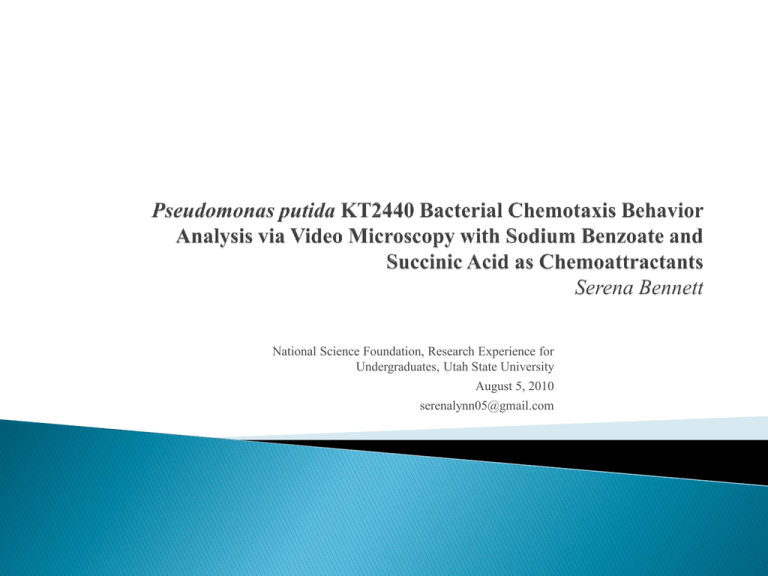
National Science Foundation, Research Experience for Undergraduates, Utah State University August 5, 2010 serenalynn05@gmail.com Problem Pseudomonas Putida KT2440 Key Words Objective Equipment Chemoattractants Growth Curve Phases Results/Data Growth Curve Parameter Velocity Turn Angle X vs. Y Displacement Project Contribution Conclusion Future Work Acknowledgements References Questions Due to pesticides, oil spills, landfill leaching etc; soil is contaminated with toxic chemicals: Water Contamination 2,4-Dichlorophenoxyacetic acid Farmland Contamination Environmental Damage Health Risks Most widely used herbicide in the world Major component in Agent Orange Toluene Naturally occurring in crude oil Byproduct of gasoline production Napthalene Nitrobenzene Toxic Chemicals In Soil Effects Chemotaxis: The observable reaction of an organism moving toward or away from the concentration of a certain chemical. Chemoattractant: A certain chemical that the organism of interest is attracted to. Video Microscopy: Microscopic analysis of nano sized samples to capture real time videos: 15 frames/second Motile due to flagella Non-pathogenic: Safe to be released into the environment Chemotactic towards soil pollutants ◦ Naphthalene ◦ Toluene ◦ Certain aromatic compounds 4-hydroxybenzoate ◦ 2,4-Dichlorophenoxyacetic acid Degrades certain toxic chemicals http://genome.jgi-psf.org/psepu/psepu.home.html Taken by Serena Bennett with IX71 inverted microscope at 60X magnification at 15 frames/sec. Observe P. Putida characteristic reactions/indicators from exposure to two separate chemoattractants: Succinic Acid (Succinate) Sodium Benzoate Compare Growth Curve Parameters Velocity (Individual bacterium) Turn Angle (Individual bacterium) Displacement (Individual bacterium) Spectrophotometer ◦ Measures absorbance (optical density) Proportional to concentration IX71 Inverted Video Microscope ImagePro v. 6.1 OriginPro v. 7.5 PPKT2440 ◦ (Olympus, Center Valley, PA, USA) ◦ Digital CCD camera (Olympus DP30BW ◦ (Media Cybernetics, Bethesda, MD, USA) ◦ Image Analysis ◦ (OriginLab Northampton, MA, USA) ◦ Lysogeny Broth http://www.olympusamerica.com/seg_section/product. asp?product=1023&p=72 Succinic Acid 15mM ◦ 88.5mg in 50ml LB ◦ Autoclave Sodium Benzoate 25mM ◦ 180mg in 50ml LB ◦ Autoclave Concentrations taken from Nisar Ahmed Kanhar experiment, Utah State University. General Phases Early Logarithmic Mid Logarithmic Late Logarithmic Early Stationary Phases Compared in KT2440 Project OriginPro ◦Sigmoid Fit ◦Modified Gompertz Equations 1) 2) 3) 4) OriginPro fitted growth curve of PPKT2440 with no chemoattractant. OriginPro growth curve of PPKT2440 with 25mM Benzoate OriginPro growth curve of PPKT2440 with 15mM Succinate A=a-asymptote-highest point in curve k=rate coefficient Xc= Center point of inflection µm=Maximum specific growth rate λ = Lag Phase Early Logarithmic Phase Late Logarithmic Phase Mid Logarithmic Phase Early Stationary Phase Smaller Turn Angle=Less Direction Change PPKT2440 without chemoattractant favors small angles (under 90°). Notice bimodal distribution in above succinate experiment. Mid Logarithmic Phase Late Logarithmic Phase Mid Logarithmic Phase Late Logarithmic Phase Mid Logarithmic Phase Late Logarithmic Phase Without Chemoattractant With 15mM Succinate With 25mM Benzoate Previous Research Collective analysis Swarm Plates Project Contribution Individual bacterium analysis Video Microscopy Growth Curve Parameter Comparison Decreased velocity Altered turn angle distribution-bimodal Decrease in overall distance traveled 15mM Succinate Extended lag phase Lengthens distance traveled in mid log phase Higher average direction change than without chemoattractant Highest maximum absorbance 25mM Benzoate Find new sensitive indicators More frames/sec in video analysis Reactions to other chemoattractants Research specific pseudomonas genes Mutate genes to create custom bioremediator Funds from National Science Foundation ◦ Research Experience for Undergraduates Dr. YangQuan Chen ◦ Program Director Dr. Anhong Zhou ◦ Molecular and Cellular Sensing and Imaging Laboratory Dr. Charlie Miller ◦ P. Putida cells Mike Davis ◦ Technical skills Harwood, Caroline S., Kathy Fosnaugh, and Marilyn Dispensa. "Flagellation of Pseudomonas putida and Analysis of Its Motile Behavior." Journal of Bacteriology. 171.7 (1989): 4063-4066. Parales, Rebecca E., and John D Haddock. "Biocatalytic degradation of pollutants." Elsevier. 15. (2004): 374-379. Reva, Oleg N. , Christian Weinel, Miryam Weinel, and Kertsin Bohm. "Functional Genomics of Stress Response in Pseudomonas putida KT2440." Journal of Bacteriology. 188.11 (2006): 4079-4092. Ford, Roseanne M., and Ronald W. Harvey. "Role of chemotaxis in the transport of bacteria through saturated porous media." Elsevier. 30. (2007): 1608-1617. Kim, Hye-Eun, Maiko Shitashiro, Akio Kurodo, Noboru Takiguchi, and Junichi Kato. “Ethylene Chemotaxis in Pseudomonas aeruginosa and Other Pseudomonas Species.” Microbes and Environments.22.2 (2007): 186-189. Hawkins, Andrew C, and Caroline S. Harwood. "Chemotaxis of Ralstonia eutropha JMP134(pJP4) to the Herbicide 2,4Dichlorophenoxyacetate." Applied and Environmental Microbiology. 68(2), (2002): 968-972. Parales, Rebecca E., Ditty, Jayna L., & Harwood, Carolin S. Toluene-degrading bacteria are chemotactic towards the environmental pollutants benzene, toluene, and trichloroethylene. Applied and Environmental Microbiology. 66(9), (2000): 4098-4104. Zwietering, M. H., I. Jongenburger, F. M. Rombouts, and K. Van't Riet. "Modeling of the Bacterial Growth Curve." Environmental Microbiology. 56.6 (1990): 1875-1881. Kanhar, Nisar Ahmed, Charles Miller, and Anhong Zhou. "Chemotactic analysis of Pseudomonas putida KT2440 and Escherichia coli TOP10 towards environmental pollutants including methyl parathion." Manuscript, Utah State University. Duffy, Kevin J., and Roseanne M. Ford. "Turn Angle and Run Time Distributions Characterize Swimming Behavior for Pseudomonas putida." Journal of Bacteriology. 179.4 (1997): 1428-1430. Questions?
